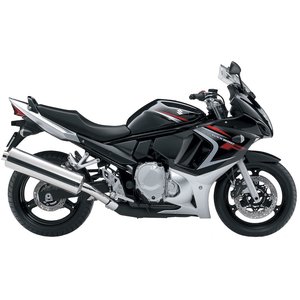Suzuki GSX 650F (2008–2016): The Versatile Sport Tourer That Defies Compromise 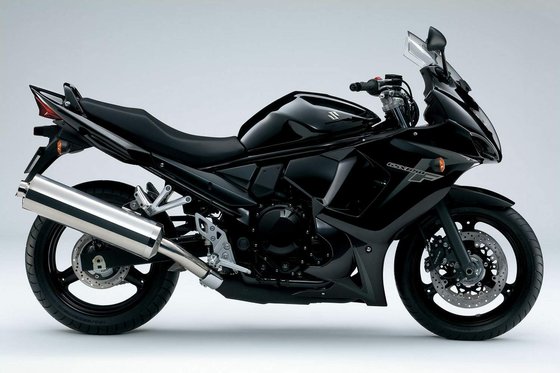
Introduction
The Suzuki GSX 650F occupies a rare sweet spot in motorcycling: a machine that delivers sportbike aesthetics and engineering without sacrificing everyday usability. Produced from 2008 to 2016, this generation carved its niche as a gateway to four-cylinder performance, offering a balanced blend of comfort, reliability, and accessible power. With its GSX-R-inspired fairing and a chassis tuned for real-world roads, it’s a bike that invites you to ride harder, longer, and more often—whether you’re carving backroads or commuting through urban sprawl. Let’s dissect why this underrated Suzuki remains a compelling choice for riders seeking practicality without apology.
Design & Ergonomics: Sporty Stance, Everyday Comfort 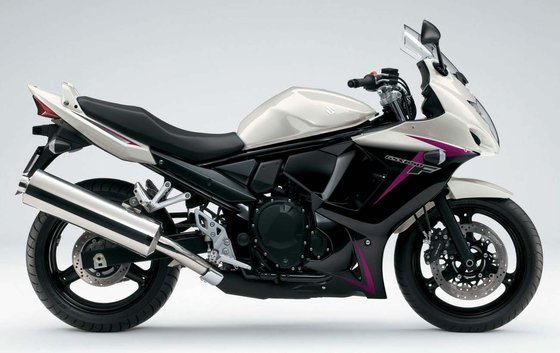
A Fairing That Means Business
Cloaked in aggressive bodywork borrowed from Suzuki’s GSX-R lineage, the GSX 650F looks every bit the sportbike at a glance. The twin headlights, angular mirrors, and layered fairing panels aren’t just for show—they provide meaningful wind protection at highway speeds. Yet unlike its track-focused siblings, this bike prioritizes rider comfort. The 770–790 mm (30.3–31.1 in) seat height accommodates shorter inseams, while the slightly raised handlebars and neutral footpeg positioning create a relaxed, upright riding triangle.
The one-piece seat deserves praise: its dense foam strikes a Goldilocks balance between support and plushness, making 300-km (186-mile) days feasible without numb limbs. Passenger accommodations are equally thoughtful, with sturdy grab rails and ample seat space.
Functional Details
Suzuki’s commitment to practicality shines in smaller touches:
- A narrow fuel tank profile (19L / 5.0 US gal capacity) improves knee grip without widening the bike’s stance.
- Rubber-mounted handlebars dampen vibrations at cruising RPMs.
- The analog tachometer and digital LCD dash (with gear indicator and shift light) prioritize readability over flashy minimalism.
Engine & Performance: Smooth Operator Meets Four-Cylinder Soul 
Power Delivery That Plays Nice
At its core lies a 656cc inline-four engine—a detuned, street-smart relative of the Bandit 650’s powerplant. With 86 HP (64 kW) @ 10,500 RPM and 62 Nm (45.7 lb-ft) @ 8,900 RPM, output leans toward midrange usability rather than peaky theatrics. Throttle response via Suzuki’s Dual Throttle Valve EFI is butter-smooth, eliminating the jerky low-speed behavior that plagues some early fuel-injected bikes.
Real-World Performance
- 0–100 km/h (0–62 mph): ~4 seconds—respectable for a 215 kg (474 lb) bike.
- Top Speed: 212 km/h (131 mph), though the sweet spot lives between 6,000–9,000 RPM for overtaking or spirited riding.
- Fuel Efficiency: 5.2 L/100 km (45.2 US mpg) under mixed conditions, extending range to ~365 km (227 miles) per tank.
The liquid-cooled DOHC engine stays composed even when pushed, thanks to Suzuki’s SCEM-coated cylinders and PVD-treated piston rings that reduce friction. Unlike high-strung supersports, the GSX 650F doesn’t punish riders for short-shifting; it’s just as happy lugging in sixth gear at 80 km/h (50 mph) as it is screaming toward redline.
Handling & Ride Experience: Confidence Inspires Fun 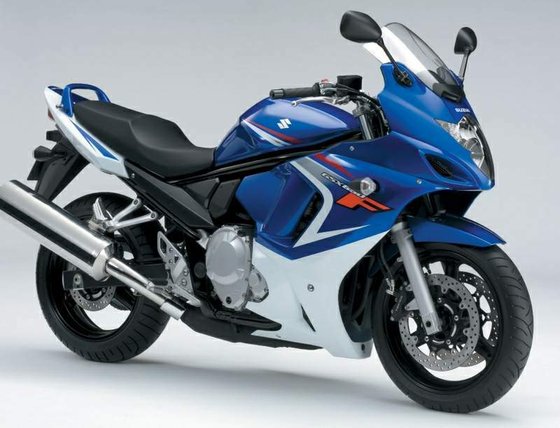
Chassis Dynamics
The double-cradle steel frame and 41mm telescopic forks prioritize stability over razor-sharp agility. With a 1,470 mm (57.9 in) wheelbase and 26° rake, the bike feels planted during high-speed sweeps yet remains flickable enough for city traffic. Preload-adjustable rear suspension (with rebound damping on later models) handles everything from solo commuting to two-up touring without drama.
Braking Performance
Dual 310mm front discs gripped by Tokico four-piston calipers provide strong, linear stopping power. ABS became optional post-2010, a worthwhile upgrade for wet-weather riders. The single 240mm rear disc lacks bite but complements the front setup well for trail braking.
Where It Shines
- City Riding: Light clutch pull and predictable throttle make stop-and-go traffic manageable.
- Twisties: Ground clearance is sufficient for spirited riding, though footpeg feelers will touch down before hard parts scrape.
- Highway Cruising: The fairing deflects windblast effectively at 120 km/h (75 mph), and vibrations only intrude above 6,500 RPM.
Competition: How the GSX 650F Stacks Up 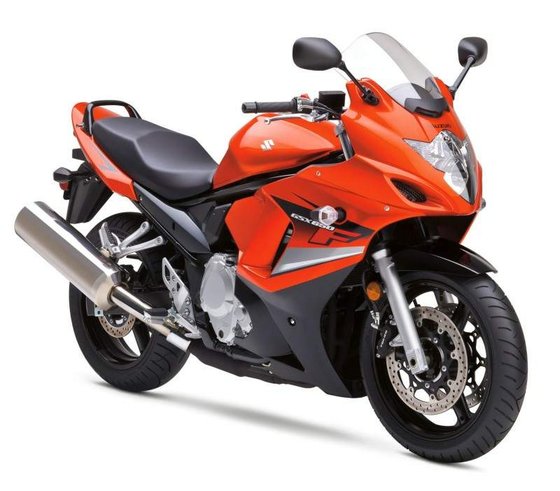
1. Kawasaki Ninja 650R (2006–2011)
- Pros: Lighter (193 kg / 425 lb), sharper handling, lower seat height (785 mm / 30.9 in).
- Cons: Parallel-twin engine lacks the GSX’s four-cylinder smoothness; cheaper suspension components.
- Verdict: The Ninja appeals to aggressive riders, while the Suzuki cossets with refinement.
2. Honda CBR600F (2011–2014)
- Pros: More powerful (100 HP), track-capable chassis, legendary reliability.
- Cons: Higher price, committed riding position, harsh seat over long distances.
- Verdict: The Honda wins on outright performance; the GSX 650F dominates comfort.
3. Yamaha FZ6 Fazer (2004–2009)
- Pros: Naked bike versatility, detuned R6 engine, lower weight.
- Cons: Minimal wind protection, buzzy handlebars at RPM >7,000.
- Verdict: The FZ6 suits urban riders; the GSX 650F is the better tourer.
Maintenance: Keeping Your GSX 650F in Fighting Shape 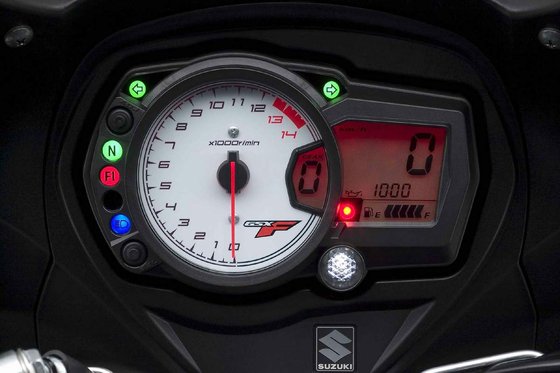
Key Service Intervals
- Oil Changes: Every 6,000 km (3,700 mi) with SAE 10W-40 (3.5L with filter). Consider MOTOPARTS.store’s synthetic blend for extended drain intervals.
- Valve Clearances: Inspect every 24,000 km (15,000 mi). Intake: 0.10–0.20 mm (0.004–0.008 in); Exhaust: 0.20–0.30 mm (0.008–0.012 in).
- Chain Maintenance: Clean and lubricate every 800 km (500 mi). The 118-link RK525 chain pairs with 15/48 sprockets—upgrade to an X-ring chain for longevity.
- Cooling System: Replace coolant every 2 years (3L capacity). MOTOPARTS.store’s high-performance coolant prevents overheating in stop-and-go traffic.
Common Upgrades
- Exhaust: Swap the bulky stock muffler for a slip-on system (check local dB laws).
- Suspension: Progressive-rate springs improve front-end feedback; a preload-adjustable shock enhances two-up stability.
- Tires: Bridgestone Battlax T32 or Michelin Road 6 tires modernize grip and wet-weather performance.
Troubleshooting Tips
- Cold Starts: If the engine hesitates, clean the throttle bodies and inspect the NGK CR8E/CR8EIX spark plugs (gap: 0.6 mm / 0.024 in).
- Brake Fade: Upgrade to sintered pads and flush fluid with DOT 4 annually.
Conclusion: The Sport Tourer That Aged Gracefully 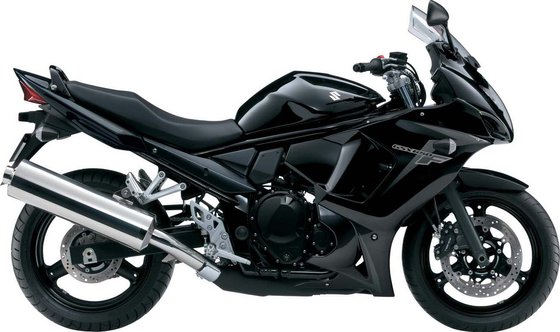
The Suzuki GSX 650F isn’t about breaking records—it’s about breaking the myth that practicality requires compromise. Its four-cylinder heartbeat delivers just enough thrill for weekend warriors, while its ergonomics and reliability make it a trustworthy daily companion. In a market obsessed with specialization, this Suzuki remains a masterclass in balance. Whether you’re a seasoned rider seeking a stress-free mount or a newcomer craving four-cylinder pedigree without the intimidation factor, the GSX 650F deserves a spot on your shortlist. And when maintenance time comes, remember: MOTOPARTS.store has the OEM-spec (or upgraded) components to keep your Suzuki running like a Swiss watch.
Ready to personalize your GSX 650F? Explore our curated selection of performance parts and accessories.
Specifications sheet
| Engine | |
|---|---|
| Stroke: | Four-stroke |
| Max power: | 64 kW | 86.0 hp |
| Max torque: | 62 Nm |
| Fuel system: | Fuel Injection (36 mm throttle body) |
| Max power @: | 10500 rpm |
| Displacement: | 656 ccm |
| Max torque @: | 8900 rpm |
| Bore x Stroke: | 65.5 x 48.7 mm (2.6 x 1.9 in) |
| Configuration: | Inline |
| Cooling system: | Liquid |
| Compression ratio: | 11.5:1 |
| Lubrication system: | Wet sump |
| Number of cylinders: | 4 |
| Dimensions | |
|---|---|
| Wheelbase: | 1470 mm (57.9 in) |
| Dry weight: | 215 |
| Wet weight: | 245 |
| Seat height: | 770 mm (30.3 in) |
| Overall width: | 760 mm (29.9 in) |
| Overall height: | 1235 mm (48.6 in) |
| Overall length: | 2130 mm (83.9 in) |
| Ground clearance: | 125 mm (4.9 in) |
| Fuel tank capacity: | 19 L (5.0 US gal) |
| Drivetrain | |
|---|---|
| Chain type: | RK525 SMOZ7Y |
| Final drive: | chain |
| Chain length: | 118 |
| Transmission: | 6-speed, cable-operated wet clutch |
| Rear sprocket: | 48 |
| Front sprocket: | 15 |
| Maintenance | |
|---|---|
| Rear tire: | 160/60 z-17 |
| Engine oil: | 10W40 |
| Front tire: | 120/70 z-17 |
| Brake fluid: | DOT 4 |
| Spark plugs: | NGK CR8E or NGK CR8EIX |
| Spark plug gap: | 0.6 |
| Coolant capacity: | 3.0 |
| Forks oil capacity: | 0.918 |
| Engine oil capacity: | 3.5 |
| Engine oil change interval: | Every 5000 km or 2 years, whichever comes first |
| Valve clearance (intake, cold): | 0.10–0.20 mm |
| Valve clearance check interval: | 24,000 km (15,000 mi) |
| Valve clearance (exhaust, cold): | 0.20–0.30 mm |
| Recommended tire pressure (rear): | 2.5 bar (36 psi) solo, 2.9 bar (42 psi) with passenger |
| Recommended tire pressure (front): | 2.5 bar (36 psi) |
| Additional Features | |
|---|---|
| ABS: | Optional on some models |
| Instrumentation: | Analog tachometer, digital speedometer, fuel gauge, gear position indicator |
| Fuel consumption (avg): | 5.2 L/100 km (45.2 US mpg) |
| Chassis and Suspension | |
|---|---|
| Rake: | 26° |
| Frame: | Double cradle steel frame |
| Trail: | 108 mm (4.25 in) |
| Rear brakes: | Single 240 mm disc, 1-piston caliper (ABS optional) |
| Front brakes: | 2 x 310 mm discs, 4-piston Tokico calipers (ABS optional) |
| Rear suspension: | Link-type monoshock, adjustable preload and rebound damping |
| Front suspension: | 41mm telescopic fork, oil damped, preload adjustable |
| Rear wheel travel: | 136 mm (5.4 in) |
| Front wheel travel: | 130 mm (5.1 in) |



